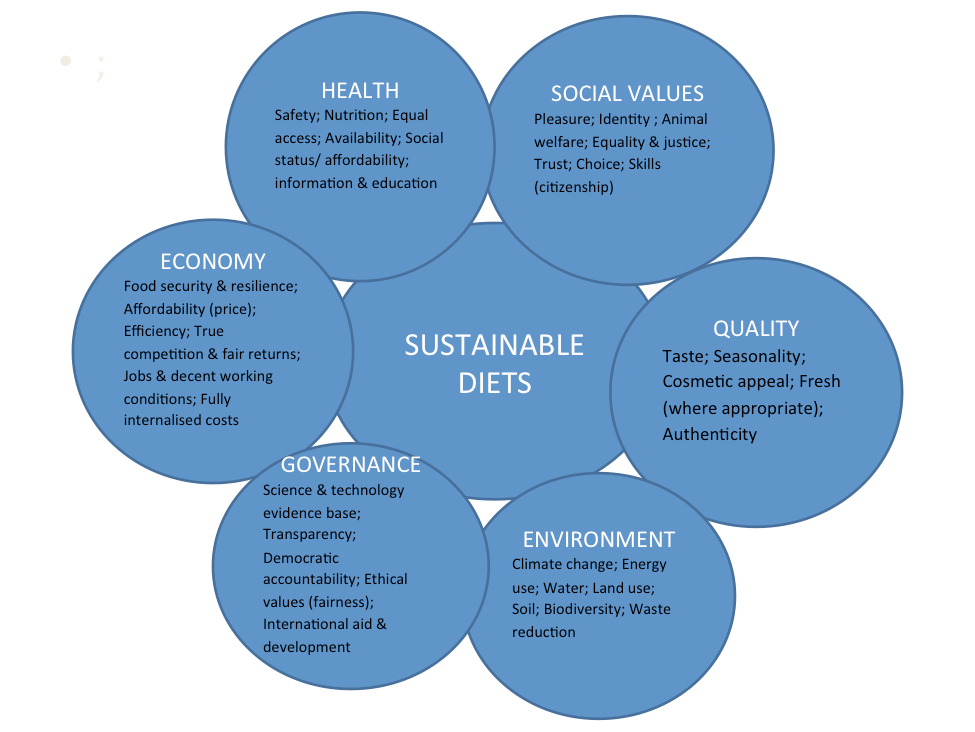How can people be fed equitably, healthily and affordably while maintaining the ecosystems on which life depends? The simple, but not so simple, answer is with a sustainable diet.
Yet this simple two-word phrase has become associated with a variety of meanings. Sustainable is often taken to mean the capacity of the environment to maintain humanity so a sustainable diet, according to this interpretation, is dietary consumption that protects the environment. Yet for a diet to be truly sustainable, it should protect human life and health in its widest sense. This includes protecting populations from diet related disease such as type 2 diabetes and cardiovascular disease, protecting people who work in the food system from poor working conditions and excess use of agricultural chemicals, paying them a living wage, improving local economies and ensuring good animal welfare, as well as protecting the health of the planet. Above all, it means everyone having access to a healthy, affordable diet, that they can obtain with dignity without having to rely on food aid, such as a food bank.
What is a sustainable diet?
Is this a tall order? Maybe it is. But a 2010 report by the FAO & Bioversity basically came up with the same idea, that “Sustainable Diets are those diets with low environmental impacts which contribute to food and nutrition security and to healthy life for present and future generations. Sustainable diets are protective and respectful of biodiversity and ecosystems, culturally acceptable, accessible, economically fair and affordable; nutritionally adequate, safe and healthy; while optimizing natural and human resources.”

Not everyone likes this definition. It’s considered too vague, too hard to achieve, too many trade-offs, and how we can achieve all of that? After all, it’s hard enough to get consumers to change their diets for health. For example, just one in four adults eat the recommended five-a-day for vegetables and fruit. And why are we talking about the need for sustainable diets anyway? Surely we have never had it so good. More people across the world are fed than ever before. The world produces enough food to feed everyone. In the UK and other rich countries food spend accounts for less than 10 per cent of income compared with a third of income 60 years ago.
And yet… during the last 10 years, food banks in Britain have become institutionalised. Between 1st April 2017 and 31st March 2018, The Trussell Trust’s food bank network distributed 1,332,952 three-day emergency food supplies to people in crisis, a 13% increase on the previous year; 484,026 of these went to children. This is a higher increase than the previous financial year, when food bank use was up by 6.64%.
Two thirds of adults, one quarter of children aged 2-10 and one third of youngsters aged 11-15 in the UK are overweight or obese. Treating obesity related conditions is estimated to cost the NHS £5.1 billion a year. The government spend of £5.2 million a year on the Change4Life healthy eating programme is tiny compared with food and drink advertising budgets. In 2017, the top 18 crisp, confectionery and sugary drink brands put £143 million into advertising in the UK. An increasing number of research studies are linking increased intake of ultra-processed food, such as snacks (e.g., biscuits, cakes, confectionery, crisps, soft drinks), sausages, bacon, cheese processed with non-traditional ingredients and some ready to eat meals with increased risk of obesity, type 2 diabetes and cancer.
Diet is associated with significant impact on the environment. Food is a major source of degradation of water, soil and biodiversity, yet we cannot see this. It’s not on a food label. Animal production is responsible for a third of all of agriculture’s greenhouse gas emissions and 36% of the calories produced by the world’s crops are used for animal feed. Only 12% of those feed calories ultimately contribute to the human diet as meat and other animal products. This is not to say that livestock have no place on the planet. Well-managed livestock within integrated farming systems can help to care for the land whilst producing good quality meat and dairy produce. But the increasing demand for meat across the world could likely only be met by intensive farming systems feeding grain to livestock. Diets from such systems are not sustainable. Good diets also require a high amount of horticultural produce yet land use is distorted by feeding ever more animals for meat and dairy. Food waste, which reduces the amount of food available to human beings, also has a significant environmental impact. If global food waste was a country it would be the third largest GHG emitter after the US and China. In the UK food waste was falling but has now stalled.
The problems associated with our diet are well rehearsed but what we can do about them? This is a challenge for sustainable diets. But what would a sustainable diet look like? Basically a sustainable diet is a plant-based diet, which means eating more vegetables, pulses and wholegrains. We need to eat a variety of foods with a rainbow of colours on our plates. We need to buy food from a credible, certified standard, pasture fed, organic, fair trade, and free range. We need to waste less food, moderate our meat consumption (both red and white) and eat fewer foods high in fat, high in salt, sugar and fat. Cooking is important but we need to be careful not to stigmatise and alienate people living in poor circumstances, for whom, fast food, for example, can be a way of gaining time and money. People on low incomes manage their households with dignity and against impossible odds.
Policy makers are not engaging significantly with the need for sustainable diets although the UK’s Eatwell Guide revised in 2016 included more guidance on sustainability than previously, advising the consumption of more plant based protein for example. Eating is, of course, a social activity and in this context Brazil’s dietary guidelines are worthy of special mention. They talk about developing and sharing food preparation skills, preparing food from fresh, healthy ingredients, the importance of regular meal times, eating together, concentrating on your food and not multitasking. They recommend buying food in shops and markets that offer a variety of fresh food, avoiding fast food chains, being critical of food industry advertising, limiting consumption of ready to eat food and drink products, and, in cooking, using fats, oils, salt and sugar in moderation.
Brazil’s approach, which has been endorsed by its Ministry of Health, and survived through recent changes of government, creates a framework for people to eat more healthily, sustainably and to enjoy their food and preparing it. Eating in this way would also send signals to the food system to change what is produced. Because this is what we need: sustainable diets from sustainable food systems.
RSA Fellow Pamela Mason is a Registered Public Health Nutritionist (UK Association for Nutrition) with an MSc in Food Policy. She is an experienced researcher in food and its links with health, the environment, society and the economy.
Related articles
-
Finding the road to renewal
Sue Pritchard
New poll by FFCC and the Food Foundation finds 85% of people want to see some of the personal or social changes they have experienced during Covid-19 continue afterwards, whilst just 9% want everything to go back to how it was before the pandemic.
-
Counting on recovery: collecting the data to inform policy post-crisis
Tom MacMillan
We’re starting to gather evidence on community responses to the pandemic, to help shape post-crisis policy. If you are too, let’s team up.
-
The Future is Here
Sue Pritchard
In a rapidly changing world, we need a stubborn optimism for the future.



Join the discussion
Comments
Please login to post a comment or reply
Don't have an account? Click here to register.
This is core to the current Brexit food and farming futures discussions and the RSA food and farming commission, I would put the cost of food that provides a healthy sustainable diet and the disengagement of many people in the increasingly urban UK with food, where it comes from and how it is produced at the heart of the Brexit debate,
Here is part 3 of my response to the comment below.
I will now comment on the links between plant-based diets and health. A healthy plant-based diet based on minimally or unprocessed plant foods is linked in the peer-reviewed scientific literature with a reduced risk of developing type 2 diabetes mellitus. Optimal macronutrient ratios (i.e. ratios of fat, carbohydrate and protein) for preventing and treating type 2 diabetes are controversial; the focus should instead be on eating patterns and actual foods. However, the evidence does suggest that the type and source of carbohydrate (unrefined versus refined), fats (monounsaturated and polyunsaturated versus saturated and trans), and protein (plant versus animal) play a role in the prevention and management of type 2 diabetes. Multiple potential mechanisms underlie the benefits of a plant-based diet in ameliorating insulin resistance, including promotion of a healthy body weight, increases in fibre and phytonutrients (plant-based nutrients), interactions between food and the gut microbial population, and decreases in saturated fat, advanced glycation endproducts, nitrosamines, and haem iron( haem iron is found principally in meat). Controlled clinical trials are beginning to look at the effect of whole food plant based diets on cardiovascular and diabetes risk factors. One such 6-month trial in New Zealand involving 65 participants with cardiometabolic disease found that compared with usual care, a whole food plant based diet reduced BMI, HBA1c; the use of medication in the intervention group was also reduced.
Single case studies (and I would emphasise these are single case studies) have been reported by US clinicians in which patients with angina, heart failure and high blood pressure have seen improvements in cardiovascular health by replacing a Western diet with a healthy whole food plant-based diet.
Here is part 2 of my response to the comment below.
On the topic of processed foods, which I mentioned very briefly in my blog, a group of academics in South America have produced a definition of what they identify as ultra-processed foods as follows: "This group includes mass produced packaged breads and buns; sweet or savoury packaged snacks; industrialised confectionery and desserts; sodas and sweetened drinks; meat balls, poultry and fish nuggets, and other reconstituted meat products transformed with addition of preservatives other than salt (for example, nitrites); instant noodles and soups; frozen or shelf stable ready meals; and other food products made mostly or entirely from sugar, oils and fats, and other substances not commonly used in culinary preparations such as hydrogenated oils, modified starches, and protein isolates. Industrial processes notably include hydrogenation, hydrolysis, extruding, moulding, reshaping, and pre-processing by frying. Flavouring agents, colours, emulsifiers, humectants, non-sugar sweeteners, and other cosmetic additives are often added to these products to imitate sensorial properties of unprocessed or minimally processed foods and their culinary preparations or to disguise undesirable qualities of the final product. " These researchers distinguish these types of foods from processed foods made to more traditional methods, such as traditionally made cheese and bread, for example. Some processing of food, which humans have done for thousands of years, is required to produce a variety of edible food.
Increased consumption and/or increased household availability of ultra-processed foods has been linked in studies by this same group of academics with obesity and cancer. If you would like to read more on this topic I can send you further details.
Here is part 2 of my response to the comment below.
On the topic of processed foods, which I mentioned very briefly in my blog, a group of academics in South America have produced a definition of what they identify as ultra-processed foods as follows: "This group includes mass produced packaged breads and buns; sweet or savoury packaged snacks; industrialised confectionery and desserts; sodas and sweetened drinks; meat balls, poultry and fish nuggets, and other reconstituted meat products transformed with addition of preservatives other than salt (for example, nitrites); instant noodles and soups; frozen or shelf stable ready meals; and other food products made mostly or entirely from sugar, oils and fats, and other substances not commonly used in culinary preparations such as hydrogenated oils, modified starches, and protein isolates. Industrial processes notably include hydrogenation, hydrolysis, extruding, moulding, reshaping, and pre-processing by frying. Flavouring agents, colours, emulsifiers, humectants, non-sugar sweeteners, and other cosmetic additives are often added to these products to imitate sensorial properties of unprocessed or minimally processed foods and their culinary preparations or to disguise undesirable qualities of the final product. " These researchers distinguish these types of foods from processed foods made to more traditional methods, such as traditionally made cheese and bread, for example. Some processing of food, which humans have done for thousands of years, is required to produce a variety of edible food.
Increased consumption and/or increased household availability of ultra-processed foods has been linked in studies by this same group of academics with obesity and cancer. If you would like to read more on this topic I can send you further details.
Here is part 2 of my response to the comment below.
On the topic of processed foods, which I mentioned very briefly in my blog, a group of academics in South America have produced a definition of what they identify as ultra-processed foods as follows: "This group includes mass produced packaged breads and buns; sweet or savoury packaged snacks; industrialised confectionery and desserts; sodas and sweetened drinks; meat balls, poultry and fish nuggets, and other reconstituted meat products transformed with addition of preservatives other than salt (for example, nitrites); instant noodles and soups; frozen or shelf stable ready meals; and other food products made mostly or entirely from sugar, oils and fats, and other substances not commonly used in culinary preparations such as hydrogenated oils, modified starches, and protein isolates. Industrial processes notably include hydrogenation, hydrolysis, extruding, moulding, reshaping, and pre-processing by frying. Flavouring agents, colours, emulsifiers, humectants, non-sugar sweeteners, and other cosmetic additives are often added to these products to imitate sensorial properties of unprocessed or minimally processed foods and their culinary preparations or to disguise undesirable qualities of the final product. " These researchers distinguish these types of foods from processed foods made to more traditional methods, such as traditionally made cheese and bread, for example. Some processing of food, which humans have done for thousands of years, is required to produce a variety of edible food.
Increased consumption and/or increased household availability of ultra-processed foods has been linked in studies by this same group of academics with obesity and cancer. If you would like to read more on this topic I can send you further details.